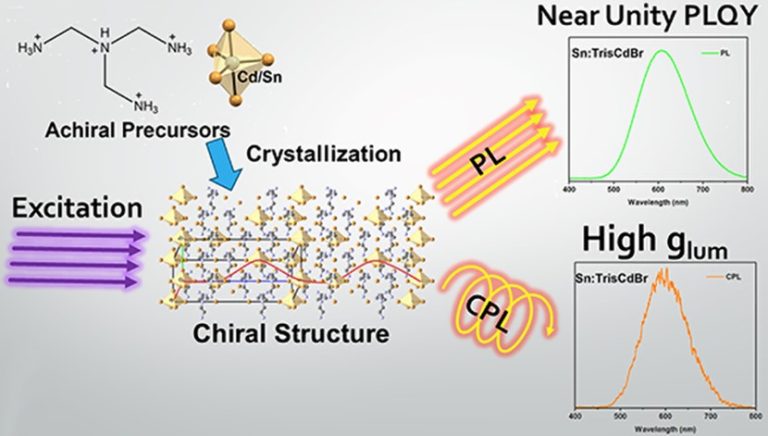WRITE UP FOR PMR FELLOWSHIP FROM MAY 2023-APRIL 2024

Deep Kumar Das
Work done under the PMR Fellowship programme:
Project:1: Efficient Circularly Polarized Dopant Luminescence and Zero Thermal Quenching in Chiral 0D Metal Halide Hybrid (CdBr5(C6H22N4)2Br5) with Achiral Components
Strongly luminescent chiral organic-inorganic metal halide hybrids with high luminescence dissymmetry factor (glum) are emergent materials with unique chiro-optical properties. Recently, chiral metal halide hybrids (MHHs) utilizing chiral organic cations have been reported. However, the strategy of structural/environmental chirality induction on MHHs incorporating achiral organic cations have not been exploited. Reported here is a chiral 0D host MHH (CdBr5(C6H22N4)2Br5) crystallizing in chiral R 32 Sohncke space group with CdBr5 units dispersed in achiral organic cation matrix. Interestingly, Sn2+ doped variant of the host hybrid, Cd0.98Sn0.02Br5(C6H22N4)2Br5, also crystallizes in chiral R 32 Sohncke space group and shows strong dopant-based, broad-band luminescence (λem~ 590 nm, lifetime ~ 3.4 μs) with near-unity photoluminescence quantum yield (PLQY~95%) and minimal thermal quenching. The observed optical properties are interpreted by DFT calculations. Importantly, the doped hybrid showcases strong circularly polarized luminescence with high glum (2×10-2). The observed chiro-optical properties of the doped hybrid chiral single crystals arise due to transfer/induction of structural/environmental chirality to achiral dopant metal halide units through extensive asymmetric hydrogen bonding interactions. This report, demonstrating induction of environmental/structural chirality to emissive dopants in chiral crystal composed of achiral components, opens new avenues for design and discovery of MHHs with multi-functional chiro-optical properties.

Project:2: Controlling Distortion in Metal Halide Unit Towards Development of Highly Emissive Tellurium (IV) Halide Hybrid
Despite strides in ‘Pb-free’ low-dimensional metal halide luminescent materials, synthesizing Te(IV) halide hybrids with strong ambient emission in the visible range remains challenging for stable lighting applications. Presented is a zero-dimensional hybrid featuring four Te-based hybrids, exhibiting visible-range excitation and room temperature, broadband luminescence from self-trapped excitons (STEs), having almost identical structures and optical properties with a huge difference in PLQY. Further, we have achieved 21% PLQY for (BzEt3N)2TeCl6 (compound 1), which is among the highest for the pure Te-based hybrid, as per our knowledge. By utilizing octahedral Te(IV)-halide units with varying static distortion, the role of 5s² lone pair electrons in shaping emissive properties is revealed. This exploration opens avenues to understand distortion and lone pair stereoactivity’s role in controlling Photoluminescence Quantum Yield (PLQY) in low-dimensional hybrids, a challenge in (Sb, Sn) based materials. This advancement marks progress towards efficient and stable Te(IV) halide hybrids for lighting applications, offering insights into structure-property relationships crucial for further development in metal halide-based luminescent materials.
External Teaching Assistantships:
Modern Engineering Materials and Instrumental Methods and Applications (at Sri Venkateshwara College of Engineering, Tirupati)
Achievements:
Best poster award at an international conference named “EMERGING MATERIALS 2023” at IISER Pune, 2023
Publications:
Efficient Circularly Polarized Dopant (Sn2+) Luminescence in Chiral 0D Metal Halide Hybrid with Achiral Components
D. K. Das, R. Bakthavatsalam, D. Sarma, A. B. Shamla, A. Mahata, V. R. Hathwar, F. D. Angelis, J. Kundu, Angewandte Chemie (Submitted)
- Bulk Coassembly of Zero-Dimensional Heterometallic Halide Hybrids for Broadband White Light Emission and Optical Thermometry
J. H. Marayathungal, D. K. Das, R. Bakthavatsalam, J. Sam, V. R. Hathwar, R. Pallepogu, S. Dutta, J. Kundu, J. Phys. Chem. C. 2023, 127, 37, 18474–18484. - Strong Dopant–Dopant Electronic Coupling in Emissive Codoped Two-Dimensional Metal Halide Hybrid
A. Kudlu, D. K. Das, R. Bakthavatsalam, J. Sam, S. Ray, P. Mondal, S. Dutta, V. R. Hathwar, R. Pallepogu, J. Kundu, J. Phys. Chem. Lett. 2023, 14, 21, 4933–4940. Mn2+-activated zero dimensional metal (Cd, Zn) halide hybrids with near unity PLQY and zero thermal quenching
J. H. Marayathungal, D. K. Das, R. Bakthavatsalam, J. Sam, V. R. Hathwar, R. Pallepogu, S. Dutta, J. Kundu, J. Phys. Chem. C. 2023, 127, 18, 8618–8630.



